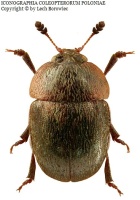Підтримуємо Вільну Україну
 We Support Free Ukraine
We Support Free Ukraine

Biodiversity Map
Taxa

-
Arthropodaphylum
Click to switch
to select orders
and filters > -
Hexapodasubphylum
Click to switch
to select orders
and filters > -
Insectaclass
Click to switch
to select orders
and filters > -
Coleopteraorder
Click to set
as the main taxon
and as a base
← of the left panel > -
Polyphagasuborder
Click to set
as the main taxon
and as a base
← of the left panel > -
Cucujiformiaseries
Click to set
as the main taxon
and as a base
← of the left panel > -
Cucujoideasuperfamily
Click to set
as the main taxon
and as a base
← of the left panel > -
Nitidulidaefamily
Click to set
as the main taxon
and as a base
← of the left panel > -
Nitidulinaesubfamily
Click to set
as the main taxon
and as a base
← of the left panel > -
Cychramusgenus
Click to set
as the main taxon
and as a base
← of the left panel >
species:
Cychramus variegatus
PL
YES
name status: valid name
BioMap ID: 1017881
taxon code: 3318
taxonomy checked: YES
Data on distribution in Poland

Statistics
- Records: 151
- Publications: 46
- Collections: 10
- Publication authors: 45
- Illustrations (iconography): 1
- Photos (specimen/observation): lacking
Taxon description
Gatunek rozmieszczony od południowych prowincji Fennoskandii i Karelii przez całą środkową Europę aż do górzystych, obszarów Francji i północnych Włoch; na wschód docierający przez Syberię do Kraju nadmorskiego i Japonii. W Europie środkowej zasiedla głównie tereny pagórkowate i górzyste. W Polsce wykazywany przeważnie z pojedynczych stanowisk w nielicznych krainach. Rozwój larwalny odbywa się w grzybach, najczęściej w opieńce — Armillariella mellea (Vahl. ex Fr.) P. Karst. Po przezimowaniu postacie dojrzałe ukazują się w kwietniu i występują do lipca; spotykane są w zbutwiałych pniach i pniakach, w hubach i grzybach nadrzewnych, pojedynczo na kwiatach krzewów i roślin zielnych, zwłaszcza baldaszkowatych.
Illustrations
... browse
 Cychramus
Cychramusvariegatus
External data sources
- Ostatnie rekordy
-
1091632
 ×
× Nitidulidae: Cychramus variegatus, PL, Puszcza Białowieska, podlaskie, 1993, leg. J.M. Gutowski (Lasoń 1999)
Nitidulidae: Cychramus variegatus, PL, Puszcza Białowieska, podlaskie, 1993, leg. J.M. Gutowski (Lasoń 1999) -
1091631
 ×
× Nitidulidae: Cychramus variegatus, PL, Puszcza Białowieska, podlaskie, 1993, leg. J.M. Gutowski (Lasoń 1999)
Nitidulidae: Cychramus variegatus, PL, Puszcza Białowieska, podlaskie, 1993, leg. J.M. Gutowski (Lasoń 1999) -
774846
 ×
× Nitidulidae: Cychramus variegatus, PL, Bieszczady, dol. Wołosatki, 1997, leg. L. Borowiec, coll. Uniw. Wrocławski, ZBiTE
Nitidulidae: Cychramus variegatus, PL, Bieszczady, dol. Wołosatki, 1997, leg. L. Borowiec, coll. Uniw. Wrocławski, ZBiTE -
705424
 ⊡
⊡ Nitidulidae: Cychramus variegatus, PL, Puszcza Białowieska, podlaskie, Hajnówka, Białowieża, Białowieża, UTM FD94, 1950, leg. B. Burakowski, coll. MiIZ PAN
Nitidulidae: Cychramus variegatus, PL, Puszcza Białowieska, podlaskie, Hajnówka, Białowieża, Białowieża, UTM FD94, 1950, leg. B. Burakowski, coll. MiIZ PAN -
705423
 ⊡
⊡ Nitidulidae: Cychramus variegatus, PL, Puszcza Białowieska, podlaskie, Hajnówka, Białowieża, Białowieża, UTM FD94, 1950, leg. B. Burakowski, coll. MiIZ PAN
Nitidulidae: Cychramus variegatus, PL, Puszcza Białowieska, podlaskie, Hajnówka, Białowieża, Białowieża, UTM FD94, 1950, leg. B. Burakowski, coll. MiIZ PAN -
705422
 ⊡
⊡ Nitidulidae: Cychramus variegatus, PL, Puszcza Białowieska, podlaskie, Hajnówka, Białowieża, Białowieża, UTM FD94, 1950, leg. B. Burakowski, coll. MiIZ PAN
Nitidulidae: Cychramus variegatus, PL, Puszcza Białowieska, podlaskie, Hajnówka, Białowieża, Białowieża, UTM FD94, 1950, leg. B. Burakowski, coll. MiIZ PAN -
705421
 ⊡
⊡ Nitidulidae: Cychramus variegatus, PL, Puszcza Białowieska, podlaskie, Hajnówka, Białowieża, Białowieża, UTM FD94, 1950, leg. B. Burakowski, coll. MiIZ PAN
Nitidulidae: Cychramus variegatus, PL, Puszcza Białowieska, podlaskie, Hajnówka, Białowieża, Białowieża, UTM FD94, 1950, leg. B. Burakowski, coll. MiIZ PAN -
705419
 ⊡
⊡ Nitidulidae: Cychramus variegatus, PL, Puszcza Białowieska, podlaskie, Hajnówka, Białowieża, Białowieża, UTM FD94, 1950, leg. B. Burakowski, coll. MiIZ PAN
Nitidulidae: Cychramus variegatus, PL, Puszcza Białowieska, podlaskie, Hajnówka, Białowieża, Białowieża, UTM FD94, 1950, leg. B. Burakowski, coll. MiIZ PAN -
705418
 ⊡
⊡ Nitidulidae: Cychramus variegatus, PL, Puszcza Białowieska, podlaskie, Hajnówka, Białowieża, Białowieża, UTM FD94, 1950, leg. B. Burakowski, coll. MiIZ PAN
Nitidulidae: Cychramus variegatus, PL, Puszcza Białowieska, podlaskie, Hajnówka, Białowieża, Białowieża, UTM FD94, 1950, leg. B. Burakowski, coll. MiIZ PAN -
705417
 ⊡
⊡ Nitidulidae: Cychramus variegatus, PL, Puszcza Białowieska, podlaskie, Hajnówka, Białowieża, Białowieża, UTM FD94, 1950, leg. B. Burakowski, coll. MiIZ PAN
Nitidulidae: Cychramus variegatus, PL, Puszcza Białowieska, podlaskie, Hajnówka, Białowieża, Białowieża, UTM FD94, 1950, leg. B. Burakowski, coll. MiIZ PAN - ... more
- Powiązane publikacje
-
Lasoń A., Marczak D., Kubisz D., Tykarski P. 2011. Kateretidae and Nitidulidae (Coleoptera) of the Mazovian Lowland. Pol. Pismo Ent., 80(2):299-320.
 full text
full text Show records
Show records -
Mokrzycki T. 2007. Waloryzacja ekosystemów leśnych Gór Świętokrzyskich na podstawie struktury zgrupowań chrząszczy związanych z pniakami. [In:] Borowski J., Mazur S. (Eds.) Waloryzacja ekosystemów leśnych Gór Świętokrzyskich metodą zooindykacyjną. Wydawnictwo SGGW, Warszawa. pp. 148-193.
 Show records
Show records -
Löbl I., Smetana A. 2007. Catalogue of Palaearctic Coleoptera. Vol. 4. Elateroidea, Derodontoidea, Bostrichoidea, Lymexyloidea, Cleroidea, Cucujoidea. Apollo Books. 935 pp.
 Show records
Show records -
Byk A. 2007. Waloryzacja lasów Gór Świętokrzyskich na podstawie struktury zgrupowań chrząszczy saproksylicznych. [In:] Borowski J., Mazur S. (Eds.) Waloryzacja ekosystemów leśnych Gór Świętokrzyskich metodą zooindykacyjną. Wydawnictwo SGGW, Warszawa. pp. 57-118.
 Show records
Show records -
Borowski J. 2007. Waloryzacja drzewostanów Gór Świętokrzyskich przy wykorzystaniu mycetobiontycznych chrząszczy grzybów nadrzewnych. [In:] Borowski J., Mazur S. (Eds.) Waloryzacja ekosystemów leśnych Gór Świętokrzyskich metodą zooindykacyjną. Wydawnictwo SGGW, Warszawa. pp. 119-147.
 Show records
Show records - ... more




